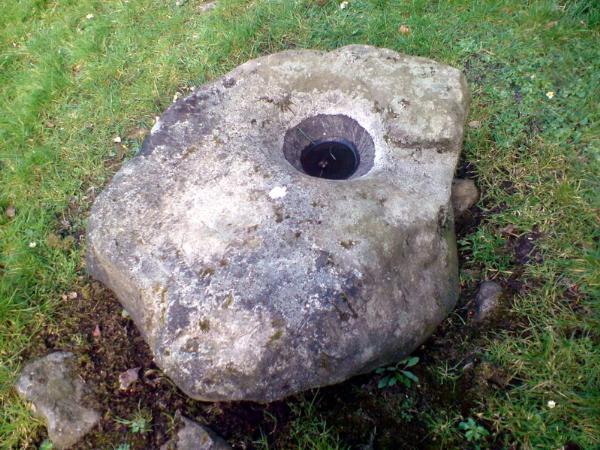La Loo
From Ballinderry Lower take the Portmore Road. Travel to the fork in the road, then take left on Dornans Road, and continue to the end of the road. There is parking space at N54 32.984 W006 16.441.
The sign post says “Portmore Cemetery”, but the historic name is La Loo graveyard. La Loo Church (probably Lann Lua “St. Molua’s church) was the original pre-Reformation place of worship of the Ballinderry area.
In the graveyard the two stone gable walls of the “Old Church” still stand - one of them with a lush covering of dark green ivy, and along with traces of the sidewalls they indicate a fairly large church for the period and the rural location.

Close by it in the graveyard are two rude basins hollowed out of boulder stones, these may have been used as fonts.

Other notable features of the early Irish church were handbells and the tall towers from which they were rung.
The site is actually a little hill, and was formerly an island on marshy ground near Portmore Lough, and the scene of regular pilgrimages until 1847.
Jeremy Taylor preached in the “Old Church” for some years while a guest of Lord Conway in the late 1640s. Taylor had been a Fellow of All Souls, Oxford, and a member of the King’s household. As a writer he was a main rival of Milton. Many of his works contained pleas for tolerance in religion.
What was a churchman and scholar as distinguished as Taylor doing in small church in a County Antrim marsh? It seems that he was in some sort of exile, or at least lying low, during the Cromwellian Commonwealth, after having served as a Chaplain to the forces of King Charles I in the Civil War, and having been captured in Wales.
The following is from the Shell Guide to Ireland (1962/67), under the heading BALLINDERRY, LOWER:
“I mile WNW, by Lough Beg, alias Portmore Lough, the remains of Ballinderry First Church, alias Portmore Church, and two bullains mark an early monastic site. The church is that “half ruined church of Kilulta” where Jeremy Taylor (1613-67), afterwards Protestant bishop of Dromore, “often preached to a small congregation” at the time he found refuge from the Cromwellians in Lord Conway’s nearby house of Portmore. It was at Portmore that Taylor wrote (1659) the preface to Ductor Dubitantium, dedicated to Charles II, and Swallow Island in the Lough was a favourite retreat of his.”
Taylor instructed that a new church ( Middle Church ) should be built in 1664 and gave the money to have the church built. He felt the new church should be in a more central position in the parish, half way between Upper and Lower Ballinderry, hence the name “The Middle Church”. ( See Church Micro 583 - Middle Church Ballinderry GC1PKJK ).The roof timbers, the Pulpit and the pews of the old La Loo church at Portmore were removed and used in this new building. Bishop Taylor died at the age of 55 in 1667, a year before his church was consecrated.
Middle Church has straight high-backed pews made of Irish oak and a centrally placed three tier oak pulpit. There is a local tradition that the huge pew opposite the pulpit was reserved for Lord Conway. Although not in regular use throughout the year because of no artificial light or heating, the Middle Church is used for services at Easter, Christmas and occasional evening prayer during the summer months, including baptisms, weddings and burials.
The Middle Church has an atmosphere all its own, puritan in style, simple and unadorned – “The finest example of a plantation church in Ireland today”. It is said that in no country church can better examples of the conditions under which worship was held over 300 years ago be found - the great family pews, high and uncomfortable, the old central pulpit in 3 stages, rising one above the other, where the wardens sat in the lowest section called the AMEN corner. They led the congregation in saying the Amen because in those days few people could read, so they needed to know when to say Amen. There are no nails in the pulpit, it is held together with wooden pegs. The wide stone paved aisle, the small red tiled chancel and the bell cot on the west gable are also characteristic of churches 300 years ago.
The ceiling of this church with its oak beams is of great interest, it would be virtually impossible to replace all those oak beams today. The communion table is a plain square table, - not in the least altar like in its shape or design. There is still one piece of 17th century communion silver used in this church, a large chalice that bears the inscription “The Ballinderry Chalice”. The font is also made of a large piece of oak with a stone bowl on top. Other things worth noting are the large wooden alms box dated 1706 and the collection pans with their long wooden handles.
Middle Church ceased to be the parish church in 1824 when the present parish church was consecrated. In 1822 there was a great debate in the parish as to whether Middle Church should be demolished and a new one erected on the same site or a new church be built elsewhere. Happily they decided to go elsewhere and the Middle Church survived. Then by 1900 the roof was in a bad state and Mrs Maria Octavia, the wife of the local Squire gave the sum of £2,000 to have it renovated. If this hadn’t happened, Middle Church today would just be a roofless ruin.
The cache is located in the graveyard at the La Loo Old Church. Please note that the cache is not placed at or near a grave.